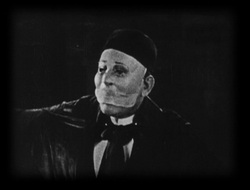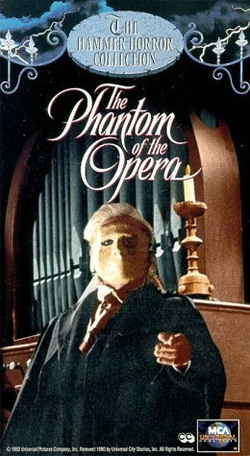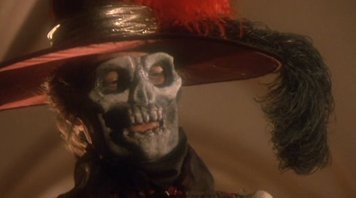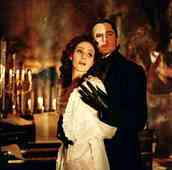This section is a division of Phantom of the Opera facts, and details the many different versions of Phantom, the masks, and the story. Warning: This also means the images. If you are easily frightened, do not continue to read this. Some of the most graphic images I have censored for you, meaning you have to click the revealer button to see them. Do not click or continue if you're squeemish...the unmasked versions are mostly hidden.
1925 The Phantom of the Opera
The first ever version of Phantom, the 1925 version was released in sepia, silent film, black-and-white, and is now sold in countless versions. Among these versions are the 1930 International Version (part talkie, with color and revamped text slides), the Original Silent Version (which was in black and white with no speech), the Studio Print (which included outtakes from the 1930 version), and the Technicolor Version. The story behind this film is long and complicated, but it's quite interesting when one thinks about it. This film was also one of the last places where we see Gaston Leroux, the author of The Phantom of the Opera, alive. He attended the premier of the film before dying shortly afterwards. Anyway...continuing!
The General Gist of It

The 1925 version was, as stated, the first ever Phantom film. Directed by Rupert Julian, starring Lon Chaney Sr. as Erik, Mary Philbin as Christine, Normal Kerry as Raoul, and using a modified version of Bach's Toccata and Fugue in D Minor as the theme, this version of Phantom has been praised as the most concise in terms of following the storyline laid out by Leroux.
The film, however, met a crap load of barriers. The first version was shown to experimental audiences in Los Angeles on January 6th and 26th in 1925. This version had music composed by J. Carl Breil, and had an anticipated release of February of that year. However, due to poor reviews from the screening audience, the film was pulled from screens, and its February release was promptly murdered. At this point, Rupert Julian was told to re-shoot almost the entire movie. Feeling that he was "too good" for the studios (what a self-centered airhead) that had replaced director Von Stroheim in the 1925 film The Merry Go-Round (sounds manly and threatening, doesn't it? Hehehe), he abruptly walked out like a twit.
The director of the later 1929 film The Cameraman, Carl Laemmel was then hired to re-shoot the film. For this film, Raymond Schrock and Elliot Clawson were directed to write new scenes. Due to the public's idiotic need of "more comedy, less tragedy," the film was made more comical (now what dipstick came up with that idea!?), and featured many added scenes which used Chester Conklin and Vola Vale as comedic relief (that wasn't ever supposed to be there!), as well as a scene in which featured Ward Crane as "Count Ruboff" (what idiot named him!?), who dueled with Raoul for Christine's affection. Needless to say, this sucky version of Phantom was screened on April 26, 1925 to an experimental audience in San Francisco, and got horrid reviews. One reviewer even commented that the film "dragged on to the point of [nausea]."
On September 6, 1925, the third and final release of the film was released. This version was the result of Universal hold-overs Maurice Pivar andLois Weber, who cut the film down to a length of nine reels. In Astor, for the opening of the movie, Universal even had a full organ placed in the theater to play the music for the film. This version grossed over 2,000,000 American US Dollars!
In November 1929, Universal hired Ernst Leamemel to re-shoot a little under half of the film for sound dubbing with the Western Electric sound-on-disk process. However, due to the fact that Chaney was working with MGM, and had a contract which did not allow Universal to dub his voice, many of Erik's scenes were switched to a more third-person view. Meaning? Some dude made shadows on walls on the set which appeared to be the outlined shadows of Chaney speaking. The voice-overs are uncredited, though it's speculated that Phillips Smalley was used for Erik's new voice. It also stated in ads that "Chaney's portrayal is a silent one!" After grossing another million, the film was stored away for later, but has since been labeled "majorly missing in action, where the hell did we put that movie!", and is now considered a lost film. Oddly enough, the sound tapes still survive from the film.
The makeup for Erik was ingeniously thought up by Lon Chaney Sr. himself. As such, Chaney upheld his reputation for not only portraying grotesque characters well, but also ingeniously designing his own grotesque makeup. An example of this includes his makeup in his 1923 film,The Hunchback of Notre Dame. He also showed his adaptability in many other films besides Phantom, including his 1920 performance in The Penalty, and his 1927 performance as Alonzo the Armless in The Unknown. Below is the revealer button for the image of Lon's unmasked Phantom. The image is from scottshaw.org.
The film, however, met a crap load of barriers. The first version was shown to experimental audiences in Los Angeles on January 6th and 26th in 1925. This version had music composed by J. Carl Breil, and had an anticipated release of February of that year. However, due to poor reviews from the screening audience, the film was pulled from screens, and its February release was promptly murdered. At this point, Rupert Julian was told to re-shoot almost the entire movie. Feeling that he was "too good" for the studios (what a self-centered airhead) that had replaced director Von Stroheim in the 1925 film The Merry Go-Round (sounds manly and threatening, doesn't it? Hehehe), he abruptly walked out like a twit.
The director of the later 1929 film The Cameraman, Carl Laemmel was then hired to re-shoot the film. For this film, Raymond Schrock and Elliot Clawson were directed to write new scenes. Due to the public's idiotic need of "more comedy, less tragedy," the film was made more comical (now what dipstick came up with that idea!?), and featured many added scenes which used Chester Conklin and Vola Vale as comedic relief (that wasn't ever supposed to be there!), as well as a scene in which featured Ward Crane as "Count Ruboff" (what idiot named him!?), who dueled with Raoul for Christine's affection. Needless to say, this sucky version of Phantom was screened on April 26, 1925 to an experimental audience in San Francisco, and got horrid reviews. One reviewer even commented that the film "dragged on to the point of [nausea]."
On September 6, 1925, the third and final release of the film was released. This version was the result of Universal hold-overs Maurice Pivar andLois Weber, who cut the film down to a length of nine reels. In Astor, for the opening of the movie, Universal even had a full organ placed in the theater to play the music for the film. This version grossed over 2,000,000 American US Dollars!
In November 1929, Universal hired Ernst Leamemel to re-shoot a little under half of the film for sound dubbing with the Western Electric sound-on-disk process. However, due to the fact that Chaney was working with MGM, and had a contract which did not allow Universal to dub his voice, many of Erik's scenes were switched to a more third-person view. Meaning? Some dude made shadows on walls on the set which appeared to be the outlined shadows of Chaney speaking. The voice-overs are uncredited, though it's speculated that Phillips Smalley was used for Erik's new voice. It also stated in ads that "Chaney's portrayal is a silent one!" After grossing another million, the film was stored away for later, but has since been labeled "majorly missing in action, where the hell did we put that movie!", and is now considered a lost film. Oddly enough, the sound tapes still survive from the film.
The makeup for Erik was ingeniously thought up by Lon Chaney Sr. himself. As such, Chaney upheld his reputation for not only portraying grotesque characters well, but also ingeniously designing his own grotesque makeup. An example of this includes his makeup in his 1923 film,The Hunchback of Notre Dame. He also showed his adaptability in many other films besides Phantom, including his 1920 performance in The Penalty, and his 1927 performance as Alonzo the Armless in The Unknown. Below is the revealer button for the image of Lon's unmasked Phantom. The image is from scottshaw.org.

1943 Phantom of the Opera
Universal...really? Again!?

Yes, it was another Universal film. In this version, some of the most popular stars of the time were casted as the characters. Unfortunately, the idiots at Universal decided on something... Here's how the issue was probably concluded. OMG! Dude! That's, like, genius, dude! We should totally just rip off Phantom, make him a violinist, and screw up his name, making him Erique Claudin! Blah, you fail, Universal. Still, it was decent. Released August 27, 1943, this version was directed by Arthur Lubin, and featured Claude Rains as Phantom. The replica of the Paris Opera House set from the 1925 film was used (oooh, I bet it was haunted by the ghost of Chaney! I can just imaging it! Chaney floating around moaning repeatedly: "You idiots killed my by spraying hazardous fake snow in my face, which lodged in my lungs and resulted in my death! Now I will kill you!" Anyway...), and the set is still in existence today. The film was made in Technicolor, and had little in common with the epic 1925 version. They made no attempt for the Masque of Red Death (commonly known as the ballroom) scene filming, cutting it out entirely, but they decided to re-enact the chandelier scene on what Wikipedia claims was in "epic" proportions. The film used elaborate camera setup, and had a huge budget of 1.5 million US Dollars.
There were plans for a sequel, which would be entitled The Climax. However, due to many reasons, they cancelled the sequel. Universal did make a film entitled The Climax, but it had nothing to do with Phantom. Failure, Universal, epic fail. Again, the revealer is below. The crappy image is courtesy (sort of) to editorsguild.com
There were plans for a sequel, which would be entitled The Climax. However, due to many reasons, they cancelled the sequel. Universal did make a film entitled The Climax, but it had nothing to do with Phantom. Failure, Universal, epic fail. Again, the revealer is below. The crappy image is courtesy (sort of) to editorsguild.com

1962 The Phantom of the Opera
1962: The Not-So-Horror-Film Horror Version

At least it has a pretty cover...
It wasn't until 1962 that another significant Phantom film was produced...and...gasp!...it wasn't from Universal! Praise! Produced by the Hammer Films Company, this version featured Herbert Lom as the Phantom figure. However, this version differs dramatically from many of the previous versions. For one thing, his name is...(*snicker*) Professor Petrie. For another thing, this version is one of a handful that show the reason for the Phantom's disfigurement. In this version, the Phantom was forced to sell his music. In rage, he burns the sheet music which was already printed inside a 1900 home (oh, I wonder why there's a giant fire in here!), which then begins to burn. Following this, he panics, and splashed Nitric Acid onto the fire, thinking it's water. The acid splashed back into his face, and he stumbles outside, falling into the river and being swept away. He is then found by the apparent eighth dwarf, who wears a tuxedo.
The chandelier scene is also extremely different. The chandelier comes crashing down not after Phantom causes it, but after the dwarf jumps on it to hide from a pursuing officer on the catwalks. Under his weight, the chandelier falls. I won't tell you want happens after that.
In this version the Phantom wears as full face mask with only one eye hole, is mute, and has an extremely unrealistic scarring on his face, as seen by the revealer below. This one, shocking, yes. Scary, no. Oh, and the unmasking scene is an epic fail. But I must say, this one is a pretty decent production. Better than Dario Argento's Phantom. Never pick that one up, and I'm not even elaborating on it. Curious, Google it.
The chandelier scene is also extremely different. The chandelier comes crashing down not after Phantom causes it, but after the dwarf jumps on it to hide from a pursuing officer on the catwalks. Under his weight, the chandelier falls. I won't tell you want happens after that.
In this version the Phantom wears as full face mask with only one eye hole, is mute, and has an extremely unrealistic scarring on his face, as seen by the revealer below. This one, shocking, yes. Scary, no. Oh, and the unmasking scene is an epic fail. But I must say, this one is a pretty decent production. Better than Dario Argento's Phantom. Never pick that one up, and I'm not even elaborating on it. Curious, Google it.

1989 The Phantom of the Opera
Nightmare on Phantom Street

At least the mask is sorta' pretty...
Produced by Dwight H. Little, this version of Phantom was an epic box office fail. This is often attributed to the fact that it was a horror film in the peak of horror-mania, and also because it was a release during the height of Andrew Lloyd Webber's musical version. This version featured a poster that read "He was Freddy... Now he's The Phantom of the Opera." Way to fail. The face behind the skull mask is similar to Freddy's, and the Phantom in this version is an instructor by the name of Dexter, played by Robert Englund. His disfigurement was caused by a curse from the devil? What the...? I'm not inquiring about it anymore. The film was released November 4, 1989, and grossed only 3.95 million US Dollars.
Within this version, the mask is made of the victims of Dexter's murders. How? He rips off their flesh and stitches it to his decaying face. However, unlike more memorable and sentimental versions, the abundance of Phantom's rope traps from Leroux's novel is a major part of the movie, and it also retains the mysterious violinist in the cemetery. However, that is the only similarity for the most part. In this rendition, Richard (who is the Raoul figure) is set ablaze, Carlotta is decapitated (aw...why didn't they do that in the 2004 version!?), and the sewer Rat Catcher meets what Wikipedia calls a "grisly fate." It's, as far as I'm concerned, the only "R" rated Phantom. Considering I couldn't find a picture of him unmasked, I slapped the promotional poster that could probably scar any five-year-old for life into the revealer.
Within this version, the mask is made of the victims of Dexter's murders. How? He rips off their flesh and stitches it to his decaying face. However, unlike more memorable and sentimental versions, the abundance of Phantom's rope traps from Leroux's novel is a major part of the movie, and it also retains the mysterious violinist in the cemetery. However, that is the only similarity for the most part. In this rendition, Richard (who is the Raoul figure) is set ablaze, Carlotta is decapitated (aw...why didn't they do that in the 2004 version!?), and the sewer Rat Catcher meets what Wikipedia calls a "grisly fate." It's, as far as I'm concerned, the only "R" rated Phantom. Considering I couldn't find a picture of him unmasked, I slapped the promotional poster that could probably scar any five-year-old for life into the revealer.

2004 The Phantom of the Opera
Screw you, critics. You're just jealous because you're nowhere near as sexy as Gerard Butler!

In the 2004 version, the film is an adaptation of Andrew Lloyd Webber's unforgettable musical. Starring Emmy Rossum as Christine and Gerard Butler as Erik, the film has received a wide range of reviews. The film does indeed focus on the scenery, and every scene is extremely beautiful, undoubtedly! The music is amazing, and the Extended Special Edition CD is worth the price tag. The sound effects are spectacular, and everything about this film is just marvelous...in my opinion. However, it doesn't exactly match the musical or the book in all manners. The scarring or disfigurement is horridly lax. Actually...it probably wouldn't scare a three-year old...it seems like they were (as YouTube's PhantomReviewer said) trying to emphasize his sexy side. Unfortunately, Phantom's not supposed to have a sexy side. Raoul hits a rather sour note in the finale, which also kills it. Way to fail, Raoul. Though it has a nice opening, it isn't exactly cannon, nor is the ending. The other thing to note is that Raoul falls into a trap and escapes because the lever is inside the trap. Now I'm sure no one as smart as Phantom would put the opening lever inside the trap! The film has some strange but nicely synchronized choreography for Masquerade, and the costumes are shockingly accurate to the time period.
